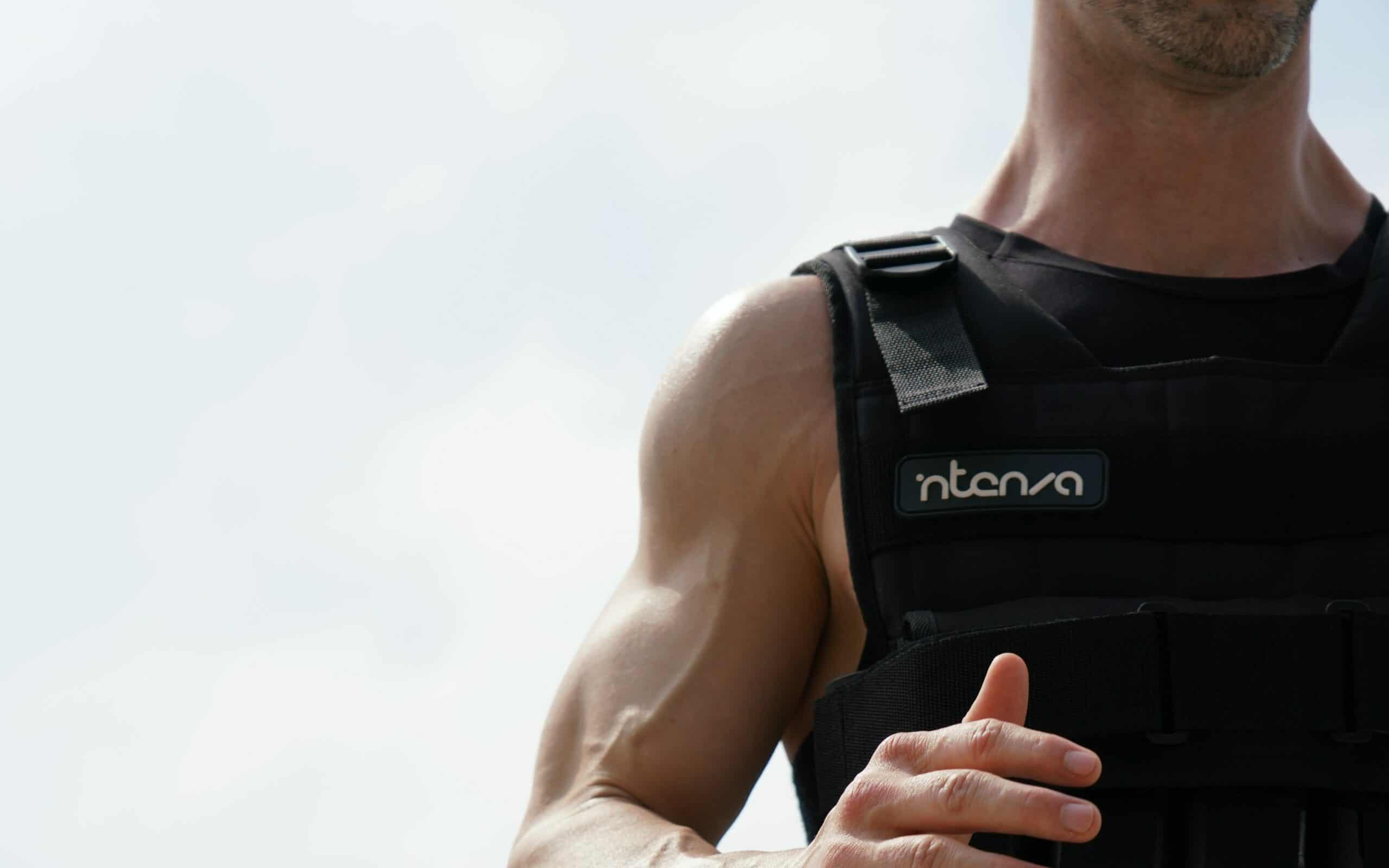Wearing a weighted vest for running is the new thing. But are weight vests worth trying? Wearing a weighted vest while running is a great way to increase the cardio intensity of your training. And if your goal is to lose weight, then throwing on a few extra lbs will make your run more challenging, helping you burn a few extra calories.
Weight vests have become especially popular in recent years thanks to the surge and increased popularity of CrossFit, and, of course, gyms closing.
So with this in mind, this blog post will explain why you may want to wear a weighted vest for running.
Related: What is Rucking? And How Will It Improve Your Running
We’ll highlight the pros and cons and also provide you with three weight vest options to get started.

Key takeaways:
- Running with a weighted vest may improve anaerobic speed
- Walk with a weighted vest before running
- Build up the weight and distance gradually to avoid injury
Why do people run with weighted vests?
Running with a weighted vest makes running more difficult.
You’re carrying a few extra pounds, which creates a new training stimulus. Your body is used to – carrying your own body mass, so clocking in a few miles with added weight may increase strength and muscular endurance, forcing your body to adapt to the resistance.
And, when you take the vest off and go for a normal run, it will feel a lot less like running uphill and more like running on a nice flat piece of road.
It’s like running on clouds. Kinda.
If you’re a newer runner, we would not recommend you start running with a weighted vest. Only use it to increase your running speed and cardio fitness after you’ve built a running base.
What are the benefits of running with a weighted vest?
Before you throw on a pack with some added weight, we recommend you read the benefits and potential downsides first. Let’s stay with the pros:
- Increased resistance
- May improve anaerobic performance
- Improved weight loss
- Improved strength
- Keep your running exciting
Increased resistance
Strapping an extra 10 lbs to your chest and going out for a run is no doubt more challenging than running without the added weight.
This extra resistance may result in strength gains, more calories burnt, and perhaps even aerobic improvements (more effort to run the same distance).
And while the performance gains are marginal, a lot of the studies did not ask participants to run or exercise with a weight vest — they instead wear a vest for several hours a day and do not exercise with it on.
It’s difficult to draw conclusions, but we can say for certain that adding resistance will make your run more challenging. Which, in turn, may lead to performance benefits.
May improve anaerobic performance
Another study looks at the effect of wearing weighted vests during daily activities for a total of 8 hours a day, 4 days a week. Results found a significant increase in sprint running performance.
But once again, the research does not investigate the effectiveness of wearing a weighted vest for running.
Although, if you want to wear a weight vest as a more “passive” form of exercise during the day, it could prove beneficial. However, you’ll have to wear it for long periods to see potential performance improvements.
Improved weight loss
The added resistance of a weight vest makes your run or workout more challenging. Often, this can mean more calories burnt to achieve more weight loss.
But to achieve lasting weight loss results, it’s essential to run with a vest that is not too heavy to avoid injury.
Also, if you don’t have the correct nutrition in place, no matter how many miles you log with a weight vest, you’ll never lose weight.
Improved strength
Adding weight to your run may lead to improvements in strength.
The additional weight adds more stress than usual to the muscles — it’s more difficult to run the same distance and at the same pace as usual. Not sure what pace to run at? We’ve got you covered.
But carrying around the extra weight challenges the muscles and forces them to adapt. It’s a type of wearable resistance training, although unique to standard strength training.
Regular running (or even walking) with extra weight may improve muscle mass. And for those with osteoporosis, it might improve bone density.
If you’re not ready to run or walk in the weight vest, beginners can consider simply doing squats to acclimate themselves to the additional weight.
Keep your running exciting
Weighted vest running will spice things up if you often find your runs boring.
Adding as little as a few extra pounds will make your run more challenging. You’ll also have to focus on maintaining proper form, balance, and coordination — you’d be surprised how much a little extra weight throws off your balance and running technique.
Also, if running with a slower friend or group, running with a little extra weight guarantees a great workout.
Are there any risks or downsides?
Running with a weighted vest does exactly that — it adds weight and resistance to your run. And while there are certainly some benefits to experience, it’s important to note potential risks and downsides.
For example, if you’re untrained or are not used to running with extra weight, a weight vest running may:
- Throw off your balance
- Increase pressure on the spine
- Worsen existing injuries (including runner’s knee)
- Increase your risk of new injuries
Throw off your balance
If you’ve never run with a heavy backpack or weight vest, then running with a vest will throw off your balance.
Your stride will feel out of whack, and you may feel your running form begin to crumble.
For this reason, as the age-old saying goes: you should walk before you run.
Weighted vest walking can help you get used to the added weight to reduce your injury risk. Research shows it’s also good cardiovascular exercise and improves skeletal system loading.
Increase pressure on the spine
Adding any amount of weight to your chest or back will inevitably increase pressure on your spine.
When running, the weight pushes down on the spine and may cause discomfort. And if you have back pain or have suffered a back injury, this may make it worse.
Worsen existing injuries (including knee pain)
Running is a weight-bearing activity — your lower extremities are required to carry your body weight. But that’s what they are used to: — carrying your own body weight.
And while adding resistance with a weight vest is a great way to add a training stimulus, it can worsen existing injuries — and that includes knee pain.
If you have knee pain or any injuries that make running painful or difficult, then it is not advised to run with a weight vest.
Increase your risk of new injuries
The weight of a vest will increase your risk of new injuries.
But there are things you can do to minimize this risk. For example, you can start by adding very light weight to your training, increasing this over time. This is similar to how you would not run a 40-mile week with no training — you need to build it up.
We also recommend that you walk before you run — allow your body time to adjust to the new training stimulus before you place a new demand on it.
When considering running with a weighted vest, consider your overall fitness level and fitness goals before committing to a run with an extra load.
The best weighted vests for runners
If you want to run (or walk) with added resistance, you can check our three best weighted vest recommendations for runners below:
- RUNMax adjustable weighted vest
- Pacearth weighted vest
- ZELUS weight vest for runners
Overall Best: RUNMax Adjustable Weighted Vest

Reasons to buy:
- Shoulder pads (optional)
- Lifetime guarantee
- Removable weights
Reasons to avoid:
- Lightest weight is 12 lbs
Our number one weighted vest option is the RUNMax adjustable weighted vest — it comes with optional shoulder pads to prevent rubbing, and a range of weights to keep your run or workout challenging.
The weights are removable (a big win), and the weight is distributed well — that means more comfort and less bouncing.
Best With Ankle & Wrist Weights: Pacearth Weighted Vest

Reasons to buy:
- Includes wrist and ankle weights (1lb each)
- Large secure mesh back pocket
- Lightest weight is 6 lbs
Reasons to avoid:
- Some runners said it runs a little big
- Weight cannot be removed from the vest
Next up, we have the Pacearth weighted vest. It also comes with wrist and ankle weights.
The weight starts at 6 lbs, providing a lighter option for those who have never tried running with a weighted vest. Although the weight is not removable, whatever weight you choose, is the weight of the vest.
There’s a large mesh pocket located on the back of the vest to store all of the essentials, including your phone, running gels, wallet, keys, and so on.
The fit is adjustable and should fit most runners well. Although, some runners said it ran a little too big — just something to take note of.
Minimal Design: ZELUS Weight Vest for Runners

Reasons to buy:
- Lightest weight is 6 lbs
- Detachable pocket (medium-sized)
- Reflective tape increases visibility
Reasons to avoid:
- Durability is not the best
- Weight cannot be removed from the vest
And finally, we have the ZELUS weight vest for runners — our best option for those looking for a minimal design with impressive visibility.
The design is similar to the Pacearth vest, but instead of a large back mesh pocket, there’s a detachable pocket on the front for easy access. It’s not as big, but it’s big enough to store the essentials.
Unfortunately, the weight on this vest is also not removable. If you’re looking for a vest that allows you to add and remove weight as needed, our number 1 option from RUNMax is the better option.
How to choose the best weight vest for you
Choosing a weight vest for running is like choosing a pair of running shoes — there is no one-size-fits-all option.
Although, there are some general guidelines we can recommend to help you choose a weight vest.
- Comfort: do the shoulder pads rub, bounce, or feel uncomfortable?
- Storage: does it include pockets to store valuables?
- Weight: how much does it weigh, and are the weights removable?
- Fit: does the weight feel evenly distributed?
How much weight should you run with?
A weighted running vest that weighs no more than 10% of your body weight should be the maximum you run with.
Although, you should build up to this by running with less weight and at a slower pace.
If you’re not ready to commit to running with a weighted vest, you can also consider walking on a treadmill with dumbbells. It’s a best practice to always consult with a personal trainer and any training plans you use to determine whether a weighted vest is the right weight to build strength for your running goals.
A weight vest may help you build muscle — it’s a type of resistance training. Your body is required to carry extra weight every stride, placing extra demand on your muscles.
A weight vest may help you build muscle — it’s a type of resistance training. Your body is required to carry extra weight every stride, placing extra demand on your muscles.
Training and running with a weighted vest will improve core strength, perhaps revealing your abs. This is because your balance is skewed, and the added resistance increases the demands on your core and lower extremities when running.





